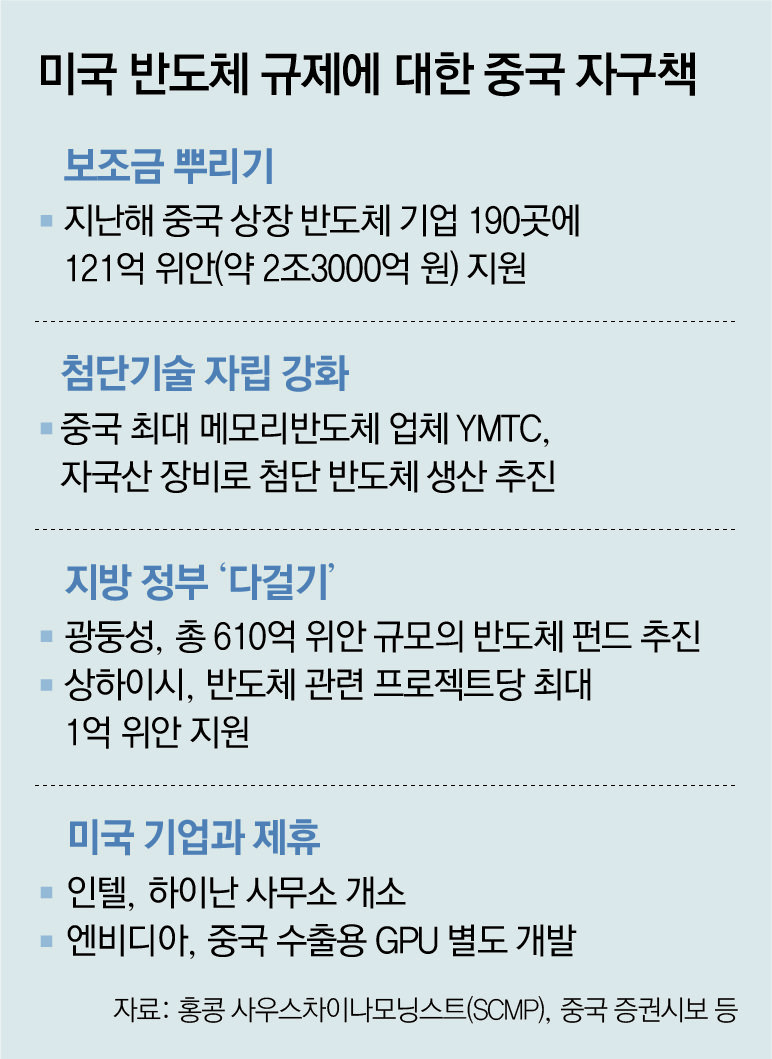U.S. Blocks Exports of Advanced Semiconductors to China
China mixes several low-performance ‘quantity over quality’
Bypass US regulations with subsidies worth 2 trillion won
WSJ “Last Attempt Uncertain Success”
China is strengthening its self-sufficiency in technology in response to the United States, which is tightening the string of ‘semiconductor blockade’ including export regulations to exclude China from the global high-tech supply chain. Some point out that the tight regulation of China by the United States can rather lead to the improvement of China’s cutting-edge technology.
The US Wall Street Journal (WSJ) reported on the 7th that China is researching artificial intelligence (AI) technology that does not depend on US high-performance high-tech semiconductors. It is said that they are looking for a way to bypass US export regulations, such as restrictions on imports of advanced semiconductor equipment from China.
According to the WSJ, there are two major detours that the Chinese information technology (IT) industry is trying. One is to use low-performance old semiconductors that are not subject to sanctions, and the other is to combine and utilize several types of semiconductors produced by China’s own technology.
Currently, the most used semiconductors in the IT industry for training high-performance large language models (LLMs) such as generative AI ‘ChatGPT’ are the state-of-the-art graphics processing unit (GPU) A100 and H100 of US Nvidia. GPU is a system semiconductor that is mainly used for learning and operating AI because it can process many calculations at the same time. Biden’s U.S. administration’s ban on exports of semiconductors to China, which was implemented in October of last year, made China no longer able to import these semiconductors.
Instead, Nvidia is supplying the Chinese market with low-performance older semiconductors, the A800 and H800, which are not subject to regulation. The WSJ evaluated the two semiconductors as “effective for developing small-scale AI, such as the video recommendation algorithm of the video platform ‘TikTok’, but has limitations in developing large-scale AI models.” Global investment bank UBS estimated that 5,000 to 10,000 high-performance semiconductors are needed for large-scale AI models such as ChatGPT. According to an investigation by the China Semiconductor Industry Association, which came out at a recent closed meeting, the current stock of A100 semiconductors secured in China is only 40,000 to 50,000. Chinese companies have chosen to save as much high-tech semiconductors as possible in case the sanctions continue. The performance of self-produced semiconductors of Chinese technology companies, including Baidu, is still poor.
Accordingly, Chinese companies such as Tencent are studying how to improve the performance of state-of-the-art semiconductors by using a lot of older semiconductors by choosing ‘quantity over quality’, the WSJ reported. Yang Yu, a professor at the National University of Singapore, explained, “To produce the same result as using 100 H100, we would need more than 3,000 H800 units.” It is also known to try to improve performance by combining several types of semiconductors so that it does not depend only on the United States. The WSJ pointed out that “combining multiple semiconductors or software technologies in general does not result in stable operation.” Susan Chang, an AI researcher at Metaplatforms, Facebook’s parent company, commented, “It is a ‘last resort’ that is rarely attempted in the United States.”

Opinions differ on the effectiveness of China’s self-rescue measures. Last year, China paid 2.3 trillion won in subsidies to 190 semiconductor companies listed on the mainland, making efforts to ‘grow up in technology’.
The WSJ analyzed, “If Chinese tech companies’ various circumvention attempts are successful, they will be able to overcome US sanctions and respond more resiliently to future restrictions.” Ji Man-soo, a senior researcher at the Korea Institute of Finance, said, “It is difficult to grow to the level of the United States only with our own technology as long as China is restricted from importing high-tech equipment.” that,” he said.
Source: Donga
Mark Jones is a world traveler and journalist for News Rebeat. With a curious mind and a love of adventure, Mark brings a unique perspective to the latest global events and provides in-depth and thought-provoking coverage of the world at large.